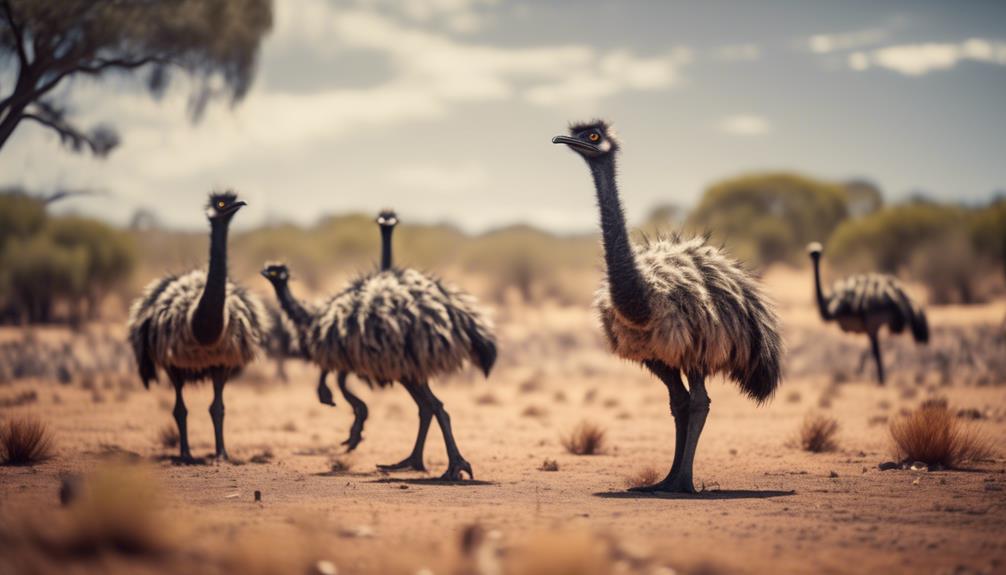
Did you know that climate change is not only affecting polar bears and coral reefs, but also emu populations and their habitats?
As temperatures continue to rise and extreme heat events become more frequent, emus are facing increasing heat stress, which can have detrimental effects on their health and survival. But heat stress is just one of the many challenges that emus are grappling with in the face of climate change.
In this discussion, we will explore the various ways in which climate change is impacting emu populations and their habitats, from changes in precipitation patterns to shifts in migration patterns, and the potential conservation strategies that can help protect these unique birds.
So, let's dive into the world of emus and uncover the hidden consequences of climate change on their existence.
Rising Temperatures and Heat Stress

Rising temperatures and heat stress have significant implications for emu populations and their habitats. They can disrupt crucial ecological processes and endanger the survival of these iconic flightless birds. Emus are adapted to thrive in diverse environments, but their physiological adaptations may not be enough to cope with the rapidly changing climate. Heat stress can lead to heat-related mortality in emus, particularly in areas where temperatures regularly exceed their physiological limits.
Emus have evolved several physiological adaptations to combat heat stress. These include their large size, feather structure, and behavior. Their large size allows them to dissipate heat more effectively, while their feathers provide insulation and regulate body temperature. Emus also exhibit behaviors such as panting and seeking shade to avoid overheating. However, these adaptations may not be sufficient to offset the increasing temperatures caused by climate change.
Studies have shown that rising temperatures can increase heat-related mortality in emus. As temperatures rise, emus may experience heat exhaustion, dehydration, and even heat stroke. These heat-related deaths can have profound impacts on emu populations, leading to declines in numbers and potential local extinctions.
The increasing frequency and intensity of heatwaves due to climate change pose a significant threat to emu populations and their habitats. It's crucial to monitor and understand the impacts of rising temperatures on these iconic birds to develop effective conservation strategies. By addressing the challenges of heat stress, we can better protect emu populations and ensure their long-term survival in a changing climate.
Changes in Precipitation Patterns
Changes in precipitation patterns have significant implications for emu populations and their habitats. These changes can influence their access to water resources and food availability. Here are three key points to consider:
- Evapotranspiration and water availability: As precipitation patterns change, so does the amount of water available to emus and their habitats. Increased evapotranspiration rates, driven by rising temperatures, can lead to decreased water availability. This can have a direct impact on emus, as they rely on water sources for drinking and bathing. Reduced access to water can also affect the availability of food sources, such as plants and insects, which emus depend on for sustenance.
- Impact on ecosystem resilience and biodiversity: Changes in precipitation patterns can disrupt the delicate balance of ecosystems, affecting the resilience and biodiversity of emu habitats. For example, prolonged droughts can lead to the loss of vegetation, reducing suitable habitats for emus and other species. This can have cascading effects on the food web and ecosystem dynamics, potentially leading to declines in biodiversity.
- Altered breeding and migration patterns: Changes in precipitation patterns can also impact the timing and location of emu breeding and migration. Emus rely on specific environmental cues, such as rainfall patterns, to trigger breeding behaviors. Alterations in precipitation patterns can disrupt these cues, affecting the reproductive success of emus and potentially leading to population declines.
Altered Food Availability and Foraging Behavior

The altered availability of food resources and changes in foraging behavior have emerged as important factors in understanding the impact of climate change on emu populations and their habitats.
As climate change affects the distribution and abundance of plant species, emus face the challenge of food scarcity in their natural habitats. This scarcity of food resources can have significant consequences for their survival and reproductive success.
Emus have evolved various foraging strategies to cope with fluctuations in food availability. They're generalist herbivores, feeding on a wide range of plant species, including grasses, fruits, seeds, and leaves. However, their foraging behavior is influenced by the availability of preferred food items. Emus will selectively consume certain plant species based on their nutritional value and abundance.
Climate change-induced alterations in the timing and intensity of rainfall can disrupt the availability of preferred food items for emus. For example, prolonged droughts can result in reduced plant growth and lower seed production, leading to a decline in food resources for emus. This can force emus to modify their foraging behavior by traveling greater distances in search of food or shifting their diet to less preferred plant species.
Understanding the impact of altered food availability and changes in foraging behavior is crucial for predicting the long-term consequences of climate change on emu populations. By studying the dietary preferences and foraging strategies of emus in response to food scarcity, scientists can develop effective conservation strategies to mitigate the potential negative effects of climate change on these iconic Australian birds and their habitats.
Disruption of Nesting and Breeding Cycles
Disruptions in nesting and breeding cycles of emus have been observed as a result of climate change. The changing climate conditions have significant effects on the nesting success and breeding success of emus. Here are three key impacts:
- Timing of nesting: Emus rely on specific environmental cues, such as temperature and rainfall patterns, to determine the optimal time for nesting. However, climate change has altered these cues, leading to mismatches between the timing of nesting and the availability of resources. As a result, emus may lay their eggs too early or too late, decreasing the chances of successful hatching.
- Reduced breeding success: Extreme weather events, such as heatwaves and droughts, are becoming more frequent and intense due to climate change. These events can directly impact the reproductive success of emus by causing heat stress, dehydration, and reduced food availability. They can also lead to increased predation as emus are forced to search for food and water in unfamiliar areas.
- Habitat loss: Climate change has resulted in the loss and fragmentation of emu habitats, which can disrupt their nesting and breeding cycles. As temperatures rise and rainfall patterns shift, suitable habitats for emus may shrink, forcing them to relocate to suboptimal areas. This displacement can disrupt their social dynamics, breeding territories, and access to suitable nesting sites, ultimately reducing their overall breeding success.
Increased Risk of Disease and Parasites

Emu populations and habitats affected by climate change also face an increased risk of disease and parasites, which can further impact their survival and reproductive success. As the climate continues to change, the distribution and abundance of disease vectors and parasites are likely to shift, increasing the exposure of emus to these health threats. Risk assessment plays a crucial role in understanding the potential impacts of climate change on disease dynamics in emu populations.
One key concern is the spread of vector-borne diseases, such as avian malaria and West Nile virus, which are transmitted by mosquitoes. As temperatures rise, the range of these disease-carrying mosquitoes is expanding, exposing emus to new areas of disease transmission. Additionally, changes in rainfall patterns can create ideal breeding conditions for these vectors, further exacerbating the risk.
Parasites also pose a significant threat to emu populations. Warmer temperatures and increased humidity can create favorable conditions for parasites to thrive and reproduce. These include internal parasites like nematodes and cestodes, as well as external parasites like ticks and mites. Infestations can lead to reduced fitness, impaired immune function, and even death in emus.
To mitigate the impact of disease and parasites on emu populations, effective disease management strategies must be implemented. This includes regular monitoring, early detection, and targeted interventions to control disease vectors and parasites. Additionally, habitat management practices that promote healthy ecosystems and reduce stress on emus can enhance their resilience to these health threats.
Habitat Loss and Fragmentation
Habitat loss and fragmentation pose significant challenges to the survival and reproductive success of emu populations. They result in the degradation and fragmentation of their natural habitats, primarily caused by human activities such as deforestation, urbanization, and agriculture expansion.
Here are three key points to consider regarding habitat loss and fragmentation:
- Habitat Degradation: Human activities, such as logging and mining, lead to the degradation of emu habitats. These activities often result in the destruction of vegetation, soil erosion, and pollution, making the habitat unsuitable for emus. The loss of vegetation reduces the availability of food and shelter, negatively impacting emu populations.
- Fragmentation of Habitat: As human activities continue to encroach upon emu habitats, the remaining areas of suitable habitat become fragmented. This fragmentation disrupts the connectivity between different parts of the habitat, making it difficult for emus to move and find resources. It also increases the vulnerability of emus to predation and reduces their ability to find suitable mates, ultimately limiting their reproductive success.
- Loss of Biodiversity: Habitat loss and fragmentation not only affect emus but also impact the overall biodiversity of the ecosystem. Emu habitats are often shared by other species, and the destruction and fragmentation of these habitats can lead to the loss of important ecological interactions and disrupt the balance of the ecosystem. This loss of biodiversity can have cascading effects on the entire ecosystem, further threatening the survival of emu populations.
Shifts in Migration Patterns

With the changing climate, there have been noticeable shifts in the migration patterns of emu populations. These shifts have been primarily driven by changes in habitat availability and quality. Emus are highly adapted to specific habitats, and any alterations in these habitats can significantly influence their migration patterns.
One of the key changes in habitat that has affected emu migration patterns is the alteration in vegetation cover. As a result of climate change, some regions have experienced shifts in rainfall patterns, leading to changes in plant growth and distribution. This has impacted the availability of suitable feeding grounds for emus during their migration. As certain areas become drier or experience reduced vegetation cover, emus may need to alter their migratory routes to find adequate food resources.
Furthermore, changes in habitat can also affect the availability of suitable nesting sites along migration routes. Emus require specific vegetation types and structures for nesting, and alterations in habitat can limit their reproductive success. For instance, if the vegetation becomes too dense or sparse, emus may struggle to find suitable locations to lay their eggs, further influencing their migration patterns.
Competition With Invasive Species
The presence of invasive species poses a significant challenge to emu populations by competing for limited resources and altering the dynamics of their habitats. This competition pressures emus to adapt and find ways to coexist with these invaders. Invasive species management becomes crucial in ensuring the survival of emus in the face of these challenges. Here are three key points to consider:
- Resource Competition: Invasive species often outcompete emus for essential resources such as food, water, and nesting sites. This can lead to a decrease in the availability of these resources for emus, forcing them to find alternative sources or adapt their behavior.
- Habitat Alteration: Invasive species can modify the structure and composition of ecosystems, which directly impacts the emu's habitat. For example, invasive plants can crowd out native vegetation, reducing the availability of suitable foraging areas for emus. This alteration can disrupt the balance of the ecosystem and negatively affect emu populations.
- Predation and Disease: Invasive species can introduce new predators or diseases to an area, posing additional threats to emus. For instance, invasive predators may target emu eggs or young chicks, leading to a decline in reproductive success. Additionally, invasive species may carry diseases that can harm emus or compete with them for hosts, further exacerbating the competition pressures they face.
Invasive species management strategies, such as monitoring and control programs, are essential to mitigate the impact of these invaders on emu populations. By understanding the competition pressures and implementing effective management practices, we can support the conservation of emus and their habitats.
Impact on Emu Population Dynamics

Emu population dynamics are significantly influenced by the impact of climate change, which has led to shifts in distribution patterns and reproductive success rates.
The effect on emu population size is a key concern in understanding the long-term implications of climate change on this species. Studies have shown that rising temperatures and changing precipitation patterns can directly impact emu populations.
For instance, increased heat stress and decreased water availability can reduce the survival rates of emu chicks, leading to a decline in overall population size. Additionally, climate change can also affect the distribution of emu populations.
As temperatures rise, suitable habitats for emus may shift, resulting in changes in their geographic range. This can lead to increased competition for resources and potential conflicts with other species.
Understanding the impact of climate change on emu population distribution is crucial for implementing effective conservation strategies. By monitoring population trends and tracking changes in distribution patterns, scientists can better predict the future of emu populations and take proactive measures to mitigate the negative effects of climate change on this iconic species.
Conservation Strategies for Protecting Emu Populations and Habitats
To effectively protect emu populations and habitats, it's essential to implement conservation strategies that address the specific challenges posed by climate change and its impact on this iconic species. Here are three key strategies that can help safeguard emu populations and their habitats:
- Community engagement: Engaging local communities and stakeholders is crucial for successful conservation efforts. By raising awareness about the importance of emu conservation and involving community members in monitoring and management activities, we can foster a sense of ownership and responsibility towards these birds and their habitats. This can lead to better compliance with conservation measures and long-term sustainability.
- Policy implementation: Strong policies and regulations are necessary to protect emu populations and their habitats. Governments and conservation organizations should work together to develop and enforce effective policies that prioritize the conservation of emus. These policies should include measures such as habitat protection, sustainable land management practices, and restrictions on hunting and poaching.
- Habitat restoration: Climate change can lead to habitat loss and degradation, which negatively impacts emu populations. Implementing habitat restoration projects, such as reforestation and wetland restoration, can help create suitable habitats for emus and improve their chances of survival. Restoring and protecting critical habitats like breeding grounds and feeding areas will be crucial for the long-term conservation of these magnificent birds.
Frequently Asked Questions
How Do Emus Adapt to Rising Temperatures and Heat Stress?
You adapt to rising temperatures and heat stress through a combination of adaptive behaviors and physiological changes. These include seeking shade, panting, reducing activity, increasing water intake, and adjusting metabolic processes to maintain body temperature.
What Are the Potential Consequences of Altered Food Availability on Emu Foraging Behavior?
Altered food availability due to climate change can have significant impacts on emu foraging behavior. As their primary food sources decline, emus may be forced to change their foraging strategies, leading to potential shifts in their feeding patterns and distribution.
How Does Climate Change Affect Emu Nesting and Breeding Cycles?
Climate change has significant impacts on emu nesting patterns and breeding behavior. Rising temperatures and altered rainfall patterns can disrupt their breeding cycles, leading to decreased reproductive success and population decline.
Are There Specific Diseases or Parasites That Emus Are More Susceptible to Due to Climate Change?
Climate change can make emus more susceptible to specific diseases and parasites. Their immune system response may be weakened, making them more vulnerable. This has implications for the health and survival of emu populations.
How Can the Impact of Climate Change on Emu Populations Be Mitigated Through Conservation Strategies?
To mitigate the impact of climate change on emu populations, conservation efforts must focus on climate change adaptation strategies. These strategies can include creating protected habitats, implementing species monitoring programs, and promoting sustainable land management practices.
Conclusion
In conclusion, the impacts of climate change on emu populations and habitats are significant and multifaceted. Research has shown that rising temperatures and heat stress can lead to reduced reproductive success and increased mortality rates among emus.
Additionally, altered precipitation patterns and shifts in food availability can disrupt their foraging behavior and breeding cycles. Furthermore, the increased risk of disease and parasites, along with competition from invasive species, further threatens emu population dynamics.
Conservation strategies must be implemented to protect these unique and vulnerable species. According to recent studies, it's estimated that emu populations have declined by 30% in the last decade alone, highlighting the urgency of action to mitigate the effects of climate change on these iconic birds.




